Stars/Galaxies/Spirals
The spiral galaxy NGC 3319 in the image on the right is about 47 million light-years away.
Radiation astronomy
[edit | edit source]Def. "[a]ny of the collections of many millions of stars ... existing as independent and coherent systems"[1] is called a galaxy.
Galactic astronomy
[edit | edit source]"The space distribution of stars and the chemical elements in the Milky Way Galaxy are discussed along with the large-scale structure and stellar content of galaxies, the solar motion, the stellar residual-velocity distribution, and the rotation of galaxies."[2]
Galactic sciences
[edit | edit source]
Probably the earliest classification of galaxies "is based on the forms of the photographic images."[3]
The spirals are divided into two types:
- Normal spirals (S) of Early (Sa), Intermediate (Sb), and Late (Sc) and
- Barred spirals (SB) of Early (SBa), Intermediate (SBb), and Late (SBc).[3]
Examples are
- Sa - NGC 4594,
- Sb - NGC 2841,
- Sc - NGC 5457,
- SBa - NGC 2859,
- SBb - NGC 3351, and
- SBc - NGC 7479.[3]
Theoretical spiral galaxy astronomy
[edit | edit source]

Def. a "galaxy having a number of arms of younger stars that spiral out from the centre containing older ones"[4] is called a spiral galaxy.
Def. a "spiral galaxy with a central bar-shaped structure composed of stars"[5] is called a barred spiral galaxy.
Ultraviolets
[edit | edit source]

The beautiful galaxy imaged on the right is tilted at an oblique angle to our line of sight, giving a "birds-eye view" of the spiral structure.
The image on the left is NGC 10 in the ultraviolet to be compared with the infrared image below and the visual one in its section.
Infrareds
[edit | edit source]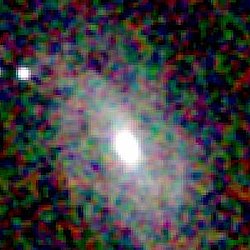
Compare this image of NGC 10 in the near-infrared with the visual image of NGC 10 in its section below.
Radios
[edit | edit source]H I regions are non-luminous, save for emission of the hydrogen line at 21-cm (1,420 MHz) spectral line. Mapping H I emissions with a radio telescope is a technique used for determining the structure of spiral galaxies.
Andromeda galaxy
[edit | edit source]
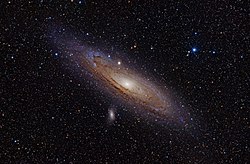

Beyond the confines of our galaxy is the Andromeda Galaxy shown on the right in an image from around 1899. This galaxy is also called Messier 31 and NGC 224.
The Andromeda Galaxy is a spiral galaxy approximately 2.5 million light-years away in the constellation Andromeda. The image on the left also shows Messier Objects 32 and 110, as well as NGC 206 (a bright star cloud in the Andromeda Galaxy) and the star Nu Andromedae. This image was taken using a hydrogen-alpha filter.
"The immense Andromeda galaxy, also known as Messier 31 or simply M31, is captured in full in this new image [second one down on the right] from NASA's Wide-field Infrared Survey Explorer, or WISE. The mosaic covers an area equivalent to more than 100 full moons, or five degrees across the sky. WISE used all four of its infrared detectors to capture this picture (3.4- and 4.6-micron light is colored blue; 12-micron light is green; and 22-micron light is red). Blue highlights mature stars, while yellow and red show dust heated by newborn, massive stars."[6]
"Andromeda is the closest large galaxy to our Milky Way galaxy, and is located 2.5 million light-years from our sun. It is close enough for telescopes to spy the details of its ringed arms of new stars and hazy blue backbone of older stars. Also seen in the mosaic are two satellite galaxies, known as M32, located just a bit above Andromeda to the left of center, and the fuzzy blue M110, located below the center of the great spiral arms. These satellites are the largest of several that are gravitationally bound to Andromeda."[6]
"The Andromeda galaxy is larger than our Milky Way and contains more stars, but the Milky Way is thought to perhaps have more mass due to its larger proportion of a mysterious substance called dark matter. Both galaxies belong to our so-called Local Group, a collection of more than 50 galaxies, most of which are tiny dwarf systems. In its quest to map the whole sky, WISE will capture the entire Local Group."[6]
LEDA 89996
[edit | edit source]
"The disc-shaped galaxy is seen face on, revealing the winding structure of the spiral arms. Dark patches in these spiral arms are in fact dust and gas — the raw materials for new stars. The many young stars that form in these regions make the spiral arms appear bright and bluish."[7]
"The galaxy sits in a vibrant area of the night sky within the constellation of Dorado (The Swordfish), and appears very close to the Large Magellanic Cloud — one of the satellite galaxies of the Milky Way."[7]
"The observations were carried out with the high resolution channel of Hubble’s Advanced Camera for Surveys. This instrument has delivered some of the sharpest views of the Universe so far achieved by mankind. This image covers only a tiny patch of sky — about the size of a one cent euro coin held 100 metres away!"[7]
The image was taken using the optical band centered on 606 nm and the infrared band centered on 814 nm.[7]
Milky Way
[edit | edit source]
The Milky Way is a name for the galaxy we live in.
It is a member of the Local Group of galaxies.
NGC 1
[edit | edit source]
The image on the right is of NGC 1 in the near-infrared J, H, and K bands. It is a distant spiral galaxy.
NGC 2
[edit | edit source]
NGC 2 is another spiral galaxy.
NGC 7
[edit | edit source]
The image on the right shows NGC 7 a spiral galaxy taken with the European Southern Observatory Schmidt 1 m telescope.
NGC 9
[edit | edit source]
NGC 9 is a spiral galaxy here on the right imaged as part of the Two Micron All Sky Survey (2MASS).
NGC 10
[edit | edit source]
NGC 10 is a spiral galaxy here on the right in the visual.
NGC 11
[edit | edit source]
In the near-infrared on the right is spiral galaxy NGC 11.
NGC 300
[edit | edit source]
"This color composite image [on the right] of nearby NGC 300 combines the visible-light pictures from Carnegie Institution of Washington's 100-inch telescope at Las Campanas Observatory (colored red and yellow), with ultraviolet views from NASA's Galaxy Evolution Explorer. Galaxy Evolution Explorer detectors image far ultraviolet light (colored blue)."[8]
"This composite image traces star formation in progress. Young hot blue stars dominate the outer spiral arms of the galaxy, while the older stars congregate in the nuclear regions which appear yellow-green. Gases heated by hot young stars and shocks due to winds from massive stars and supernova explosions appear in pink, as revealed by the visible-light image of the galaxy."[8]
"Located nearly 7 million light years away, NGC 300 is a member of a nearby group of galaxies known as the Sculptor Group. It is a spiral galaxy like our own Milky Way."[8]
NGC 1068
[edit | edit source]

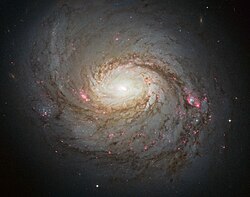
"Measurements of the polarization of the light near the nucleus of NGC 1068, a nearby and prototypical type 2 Seyfert, provided strong evidence that it actually contains a type 1 nucleus which is blocked from our direct view by an obscuring ring or torus of material. The nucleus produces a radio jet at right angles to this hypothesized torus, which must lie almost at right angles to the galaxy's disk plane. Recent VLBI observations may have detected this torus, as shown in this montage. HST images are used to show the galaxy as a whole and the conelike illumination pattern of highly ionized gas which must see the nucleus directly, then the radio jet and finally a tiny structure which has the right size, orientation, and temperature to be the obscuring disk. If this in fact the obscuring material, this is an important piece of evidence for the unified scheme for Seyfert galaxies. This is simply the notion that many type 2 Seyferts would be type 1 objects if we could see them from the proper direction, nearly along the axis of the torus so that our view is not blocked. These special directions are often marked by both radio jets and cones of intense radiation, which we see either as they ionize ambient gas or are reflected from clouds rich in dust that happen to lie within the cones."[9]
The image on the right was taken with the 32 inch Schulman Foundation telescope on Mt. Lemmon, AZ, USA.
The second image on the left is from the Hubble Space Telescope.
"The patches of red across this image highlight pockets of star formation along the pinwheeling arms, with dark dust lanes stretching across the galaxy’s energetic centre."[10]
"Messier 77 is a galaxy in the constellation of Cetus, some 45 million light-years away from us."[10]
"It is the closest and brightest example of a particular class of galaxies known as Seyfert galaxies — galaxies that are full of hot, highly ionised gas that glows brightly, emitting intense radiation."[10]
"Messier 77’s spiral arms are also very bright regions. Dotted along each arm are knotty red clumps — a signal that new stars are forming. These baby stars shine strongly, ionising nearby gas which then glows a deep red colour as seen in the image above. The dust lanes stretching across this image appear as a rusty, brown-red colour due to a phenomenon known as reddening; the dust absorbs more blue light than red light, enhancing its apparent redness."[10]
NGC 1097
[edit | edit source]
At the right is a "[c]olour-composite image of the central 5,500 light-years wide region of the spiral galaxy NGC 1097 [45 million light years away], obtained with the NACO adaptive optics on the VLT. More than 300 star forming regions - white spots in the image - are distributed along a ring of dust and gas in the image. At the centre of the ring there is a bright central source where the active galactic nucleus and its super-massive black hole are located. The image was constructed by stacking J- (blue), H- (green), and Ks-band (red) [infrared] images. North is up and East is to the left. The field of view is 24 x 29 arcsec2, i.e. less than 0.03% the size of the full moon!"[11]
NGC 1300
[edit | edit source]
"The Hubble telescope captured a display of starlight, glowing gas, and silhouetted dark clouds of interstellar dust in this [image on the right] of the barred spiral galaxy NGC 1300. NGC 1300 is considered to be prototypical of barred spiral galaxies. Barred spirals differ from normal spiral galaxies in that the arms of the galaxy do not spiral all the way into the center, but are connected to the two ends of a straight bar of stars containing the nucleus at its center."[12]
NGC 1300 is in the constellation Eridanus.[12]
The image was made with the optical blue band (435 nm), the optical visual band centered at 555 nm, optical H-alpha (658 nm), and the infrared band (814 nm).[12]
NGC 1672
[edit | edit source]
NGC 1672 in the image on the right is a spiral galaxy.
NGC 2683
[edit | edit source]
"While a bird's eye view lets us see the detailed structure of a galaxy (such as this Hubble image of a barred spiral [NGC 2683 on the right]), a side-on view has its own perks. In particular, it gives astronomers a great opportunity to see the delicate dusty lanes of the spiral arms silhouetted against the golden haze of the galaxy's core. In addition, brilliant clusters of young blue stars shine scattered throughout the disc, mapping the galaxy's star-forming regions."[13]
"This image is produced from two adjacent fields observed in visible and infrared light by Hubble's Advanced Camera for Surveys."[13]
NGC 3982
[edit | edit source]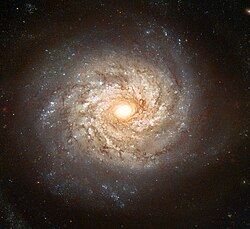
"A team of European astronomers is using the NASA/ESA Hubble Space Telescope to look back in time. They have imaged the spiral galaxy NGC 3982 [around 70 million light years away] and hundreds of other galaxies in the hope that one of the millions of stars in these images will some day explode as a supernova. They can then look back and pinpoint the exact star that has exploded. Only two such supernova 'mother stars' have ever been identified."[14]
NGC 4321
[edit | edit source]
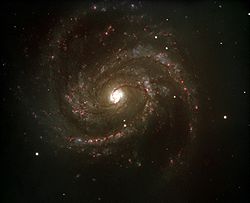
"This [visual] image [at right] from the NASA/ESA Hubble Space Telescope, the most detailed made to date, shows the bright core of the galaxy and the innermost parts of its spiral arms. Messier 100 has an active galactic nucleus — a bright region at the galaxy’s core caused by a supermassive black hole that is actively swallowing material, which radiates brightly as it falls inwards."[15] Bold added.
"Messier 100 is a perfect example of a grand design spiral galaxy, a type of galaxy with prominent and very well-defined spiral arms. These dusty structures swirl around the galaxy’s nucleus, and are marked by a flurry of star formation activity that dots Messier 100 with bright blue, high-mass stars."[15]
"The galaxy’s spiral arms also host smaller black holes, including the youngest ever observed in our cosmic neighbourhood, the result of a supernova observed in 1979."[15]
"Messier 100 is located in the direction of the constellation of Coma Berenices, about 50 million light-years distant."[15]
"This image, taken with the high resolution channel of Hubble’s Advanced Camera for Surveys demonstrates the continued evolution of Hubble’s capabilities over two decades in orbit. This image, like all high resolution channel images, has a relatively small field of view: only around 25 by 25 arcseconds."[15]
The visual data is centered at 555 nm (blue), the visual + infrared is in green, and additional infrared centered at 814 nm is red.[15]
On the left is a composite "based on five images taken with FORS1 on Kueyen (VLT) by Dominique Naef, Eric Depagne and Chris Lidman (ESO). The images were taken through different filters: U [360 nm], V [554 nm], R [600 nm], I [768 nm], and a narrow-band filter centred on the H-alpha line [656 nm]. The exposure time is 60 seconds in the V, R and I filters, 3 minutes in the U-band and 5 minutes in the H-alpha filter. The field of view is 6.8 x 5.1 arcmin2. North is up and East is to the left. The final processing was done by Kristina Boneva, Haennes Heyer and Henri Boffin (ESO)."[16]
NGC 4321 (Messier 100) is 55 million light years distant in the constellation Coma Berenices.[16]
NGC 6503
[edit | edit source]
"This new image [at right] from Hubble’s Advanced Camera for Surveys displays, with particular clarity, the pink-coloured puffs marking where stars have recently formed in NGC 6503's swirling spiral arms. Although structurally similar to the Milky Way, the disc of NGC 6503 spans just 30 000 light-years, or just about a third of the size of the Milky Way, leading astronomers to classify NGC 6503 as a dwarf spiral galaxy."[17]
"NGC 6503 lies approximately 17 million light-years away in the constellation of Draco (the Dragon)."[17]
NGC 6946
[edit | edit source]
According to NASA,[18] "NGC 6946 is a medium-sized, face-on spiral galaxy about 22 million light years away from Earth. In the past century, eight supernovas have been observed to explode in the arms of this galaxy. Chandra observations (purple [in the image at the top right of the resource]) have, in fact, revealed three of the oldest supernovas ever detected in X-rays, giving more credence to its nickname of the "Fireworks Galaxy." This composite image also includes optical data from the Gemini Observatory in red, yellow, and cyan."
Distance moduli have been estimated for NGC 6946 using its brightest blue stars and its HII ring.[19] Its distance modulus is estimated to be log D0 = 4.434.[19] The distance in parsecs is given by
where µ0 = 29.25.[19] NGC 6946 is at 106.85 (7.08 x 106) parsecs, or approximately 23.1 x 106 light years. While this is greater than the NASA number, it is not an order of magnitude greater of smaller.
Looking up "NGC 6946" on SIMBAD, without the quotes, reveals that SIMBAD considers NGC 6946 to be an "HII Galaxy" of morphological type "SAB(rs)cd".
A more extensive classification scheme starting from the Hubble scheme indicates that an Sab galaxy is approximately in between Sa and Sb.[20]
NGC 7793
[edit | edit source]
"This new image from the NASA/ESA Hubble Space Telescope shows NGC 7793, a spiral galaxy in the constellation of Sculptor some 13 million light-years away from Earth. NGC 7793 is one of the brightest galaxies in the Sculptor Group, and one of the closest groups of galaxies to the Local Group — the group of galaxies containing our galaxy, the Milky Way and the Magellanic Clouds."[21]
"The image shows NGC 7793’s spiral arms and small central bulge. Unlike some other spirals, NGC 7793 doesn’t have a very pronounced spiral structure, and its shape is further muddled by the mottled pattern of dark dust that stretches across the frame. The occasional burst of bright pink can be seen in the galaxy, highlighting stellar nurseries containing newly-forming baby stars."[21]
"Although it may look serene and beautiful from our perspective, this galaxy is actually a very dramatic and violent place. Astronomers have discovered a powerful microquasar within NGC 7793 — a system containing a black hole actively feeding on material from a companion star. While many full-sized quasars are known at the cores of other galaxies, it is unusual to find a quasar in a galaxy’s disc rather than at its centre."[21]
"Micro-quasars are almost like scale models — they allow astronomers to study quasars in detail. As material falls inwards towards this black hole, it creates a swirling disc around it. Some of the infalling gas is propelled violently outwards at extremely high speeds, creating jets streaking out into space in opposite directions. In the case of NGC 7793, these jets are incredibly powerful, and are in the process of creating an expanding bubble of hot gas some 1000 light-years across."[21]
The image is a composite of infrared (814 nm), optical violet (555 nm), optical blue (438 nm), ultraviolet (336 nm), and ultraviolet (275 nm).[21]
Orbital alignment in spiral galaxies
[edit | edit source]
Stars in a spiral galaxy move in certain orbits under the influence of the gravitational field associated with the totality of stars in that galaxy. The patterns of these orbits have been studied observationally and using simulation methods.
Using publicly available data[22] compiled from observations of the motions of over 20,000 local stars (within 300 parsecs) with Hipparcos distances, and using numerical simulation, Charles Francis and Erik Anderson have calculated that, contrary to conventional wisdom, stars tend to move along a spiral arm during the inward part of their orbits, leaving the arm shortly after pericentre crossing the other arm on the outward part of the orbit and rejoining the original arm shortly before apocentre.[23] These observations have been confirmed using a larger sample of Hipparcos stars with improved distance [24] and velocity measurements[25] by comparison with the spiral structure of the Milky Way as seen in 2MASS and in neutral gas,[26] and by analysis of the velocities of an independent sample of 52 794 RAVE stars.[27]
Evidence for the alignments has also been seen in N-body simulations by Robert Grand.[28] "We have found it impossible to reproduce the traditional theory, but stars move with the spiral pattern in our simulations at the same speed. We simulated the evolution of spiral arms for a galaxy with five million stars over a period of 6 billion years. We found that stars are able to migrate much more efficiently than anyone previously thought. The stars are trapped and move along the arm by their gravitational influence, but we think that eventually the arm breaks up due to the shear forces," said Grand.
Potential in a spiral galaxy
[edit | edit source]
The gravitational potential of a spiral galaxy is a potential well with the form of a giant, spiral-grooved funnel. The grooves represent the gravitational field of the galaxy's spiral arms. As a star nears apocentre, the slowest part of its orbit, it will tend to fall into a groove. It will then tend to follow the groove, picking up momentum as it goes, on a path closely aligned with an elliptical orbit. Near the innermost part of the orbit, the alignment between the orbital path and the arm comes to an end, and the star gains enough momentum to jump free of its groove. It crosses over the next-highest groove, then falls back to a higher point in its original groove. At the same time, the funnel may rotate slowly, so that orbits form rosettes rather than ovals.
Numerical simulation establishes that orbits can precess either prograde or retrograde due to the spiral potential, and that they tend to align with the arms such that the star follows the arm during the inward part of the orbit. The mass of the star contributes to the mass of the arm during this part of the orbit, increasing the potential. Thus, as stars are drawn into an arm, the gravitational field of the arm grows stronger, drawing greater number of stars into the arm, and reinforcing spiral structure.
Star formation in spiral arms
[edit | edit source]
Under gravity, gas clouds follow similar motion to stars. Gas in the arm is in turbulent motion, as gas clouds seek to cross in the arm and gain velocity as they approach pericentre. Whereas stars rarely collide because of their small size compared to space between them, when outgoing gas from one arm meets ingoing gas in another arm, collisions between gas clouds create regions of higher pressure, and greater turbulence. Pockets of extreme pressure due to turbulence generate the molecular clouds in which new stars form.
Bisymmetric spirals
[edit | edit source]In a multi-arm spiral, outgoing gas meeting an arm would outweigh ingoing gas in the arm. This would tend to remove gas from the arm. In a two armed spiral, the gas in the arm has greater mass. Thus, a two-armed gaseous spiral can be stable, whereas multiarmed gaseous spirals cannot. Outgoing gas applies pressure to the trailing edge of a spiral arm with an inverse proportionality to radius. If one gaseous arm advances compared to the bisymmetric position, the pressure due to gas from the other arm will be reduced. At the same time, pressure on the retarded arm due to outgoing gas from the advanced arm will be increased. Thus gas motions preserve the symmetry of two-armed spirals.
Hypotheses
[edit | edit source]- Spiral galaxies have a lot of substructure independent of the spiral arms that may lend itself to subclassification.
"Keel (1980) used a sample of 91 field spirals as the control group in a study of the effect of inclination on the recognition of Seyfert nuclei. Of these 91 galaxies, approximately 50% had a/b [axial ratio, major over minor axis, at 23 R band mag.arcsec-2] ≥ 2.0."[29]
Six of thirty "edge-on spirals [...] with a [boxy/peanut shape] B/PS bulge [...] with bulges larger than 0.6' in diameter and disks smaller than about 7.0' (at the 25 B mag arcsec-2 level). [...] All objects are accessible from the south (δ ≤ 15°). [sample galaxies ...] have a more spheroidal bulge morphology [...] have emission lines extending far enough in the disk to apply the diagnostics developed by BA99 and AB99 with the ionised gas; all galaxies in the control group fulfill [these conditions]."[30]
See also
[edit | edit source]References
[edit | edit source]- ↑ galaxy. San Francisco, California: Wikimedia Foundation, Inc. July 2, 2013. http://en.wiktionary.org/wiki/galaxy. Retrieved 2013-07-14.
- ↑ D. Mihalas, J. Binney (1981). Galactic astronomy: Structure and kinematics 2nd edition. San Francisco, CA USA: WH Freeman and Co.. pp. 608. Bibcode: 1981gask.book.....M. http://adsabs.harvard.edu/abs/1981gask.book.....M. Retrieved 2014-01-27.
- ↑ 3.0 3.1 3.2 Edwin Hubble (December 1926). "Extra-Galactic Nebulae". The Astrophysical Journal 64 (12): 321-69. doi:10.1086/143018. http://articles.adsabs.harvard.edu/full/1926ApJ....64..321H. Retrieved 2014-02-05.
- ↑ spiral galaxy. San Francisco, California: Wikimedia Foundation, Inc. October 9, 2013. https://en.wiktionary.org/wiki/spiral_galaxy. Retrieved 2014-01-27.
- ↑ barred spiral galaxy. San Francisco, California: Wikimedia Foundation, Inc. October 9, 2013. https://en.wiktionary.org/wiki/barred_spiral_galaxy. Retrieved 2014-01-27.
- ↑ 6.0 6.1 6.2 Rebecca Whatmore (17 February 2010). Our Neighbor Andromeda. Washington, DC USA: NASA. http://www.nasa.gov/mission_pages/WISE/multimedia/pia12832-c.html. Retrieved 2015-09-08.
- ↑ 7.0 7.1 7.2 7.3 c.claude (6 July 2015). Galaxy with a view. Baltimore, Maryland USA: SpaceTelescope. http://www.spacetelescope.org/images/potw1527a/. Retrieved 2015-09-08.
- ↑ 8.0 8.1 8.2 GALEX science team (7 April 2005). Classic Galaxy With Glamour. Pasadena, California USA: NASA/JPL. http://www.galex.caltech.edu/media/glx2005-01r_img01.html. Retrieved 2015-08-31.
- ↑ Bill Keel (October 2003). Galaxy, jet, and obscuring disk in NGC 1068. Tucson, Arizona USA: University of Arizona. http://www.astr.ua.edu/keel/agn/ngc1068.html. Retrieved 2014-03-19.
- ↑ 10.0 10.1 10.2 10.3 Nicky Guttridge (28 March 2013). Hubble observes the hidden depths of Messier 77. Baltimore, Maryland USA: SpaceTelescope. http://www.spacetelescope.org/news/heic1305/. Retrieved 2015-09-08.
- ↑ ESO05 (October 17, 2005). The Centre of the Active Galaxy NGC 1097. Paranal: European Southern Observatory. http://www.eso.org/public/images/eso0534a/. Retrieved 2013-03-15.
- ↑ 12.0 12.1 12.2 AURA (11 January 2005). A poster-size image of the beautiful barred spiral galaxy NGC 1300. Baltimore, Maryland USA: SpaceTelescope. http://www.spacetelescope.org/images/opo0501a/. Retrieved 2015-09-10.
- ↑ 13.0 13.1 Brian Dunbar (30 March 2012). Hubble Spies a Spiral Galaxy Edge-on. Washington, DC USA: NASA. http://www.nasa.gov/multimedia/imagegallery/image_feature_2210.html. Retrieved 2015-09-08.
- ↑ Stephen Smartt (24 September 2003). Galaxy NGC 3982. Baltimore, Maryland USA: Space Telescope. http://www.spacetelescope.org/images/heic0311a/. Retrieved 2015-08-31.
- ↑ 15.0 15.1 15.2 15.3 15.4 15.5 ESA/Hubble & NASA (January 16, 2012). Core of Messier 100 in super high res. ESA/Hubble & NASA. http://www.spacetelescope.org/images/potw1203a/. Retrieved 2013-03-14.
- ↑ 16.0 16.1 Dominique Naef, Eric Depagne and Chris Lidman (23 February 2006). Spiral Galaxy Messier 100. European Southern Observatory. http://www.eso.org/public/images/eso0608a/. Retrieved 2015-09-10.
- ↑ 17.0 17.1 ESA/Hubble and NASA (November 29, 2010). At the edge of the abyss. HubbleSite. http://www.spacetelescope.org/images/potw1032a/. Retrieved 2013-03-15.
- ↑ Brooke Boen (November 8, 2013). NGC 6946: The 'Fireworks Galaxy'. http://www.nasa.gov/mission_pages/chandra/multimedia/fireworks-galaxy-ngc6946.html#.UteCAtIW1mN. Retrieved 2014-02-08.
- ↑ 19.0 19.1 19.2 G. de Vaucouleurs (September 15, 1978). "The extragalactic distance scale. IV - Distances of nearest groups and field galaxies from secondary indicators". The Astrophysical Journal 224 (09): 710-7. http://adsabs.harvard.edu/abs/1978ApJ...224..710D. Retrieved 2014-02-08.
- ↑ Gérard de Vaucouleurs (1994). Global Physical Parameters of Galaxies. http://www.stsci.edu/institute/conference/galaxy-morphology/devaucouleurs.ps. Retrieved 2008-01-02.
- ↑ 21.0 21.1 21.2 21.3 21.4 D. Calzetti (22 September 2014). Jets and explosions in NGC 7793. Baltimore, Maryland USA: SpaceTelescope. http://www.spacetelescope.org/images/potw1438a/. Retrieved 2015-09-08.
- ↑ This work has made use of the VizieR catalogue access tool, CDS, Strasbourg, France. The original description of the VizieR service was published in A&AS 143, 23; http://vizier.u-strasbg.fr/viz-bin/VizieR
- ↑ Francis, Charles; Anderson, Erik (8 November 2009). "Galactic spiral structure". Proc. R. Soc. A 465 (2111): 3425–3446. doi:10.1098/rspa.2009.0036.
- ↑ van Leeuwen, F. (2007). Hipparcos the New Reduction of the Raw Data (CDS Catalog: I/311). Springer.
- ↑ ,Francis, Charles; Anderson, Erik (April 2014). "The local standard of rest and the well in the velocity distribution". Celestial Mechanics and Dynamical Astronomy 118: 399-413. doi:10.1007/s10569-014-9541-z.
- ↑ Francis, Charles; Anderson, Erik (19 March 2012). "Evidence of a bisymmetric spiral in the Milky Way". MNRAS 422: 1283–1293. doi:10.1111/j.1365-2966.2012.20693.x.
- ↑ Francis, Charles (1 Oct 2013). "Calibration of RAVE distances to a large sample of Hipparcos stars". MNRAS 436: 1283-1293. doi:10.1093/mnras/stt1651.
- ↑ Royal Astronomical Society News, NAM 21: New theory of evolution for spiral galaxy arms, http://www.ras.org.uk/1967-new-theory-of-evolution-for-spiral-galaxy-
- ↑ Lee Armus and Timothy Heckman, Geoge Miley (October 1987). "Multicolor optical imaging of powerful far-infrared galaxies - More evidence for a link between galaxy mergers and far-infrared emission". The Astronomical Journal 94 (4): 831-46. doi:10.1086/114517. http://adsabs.harvard.edu/abs/1987AJ.....94..831A. Retrieved 2014-01-27.
- ↑ M. Bureau and K. C. Freeman (July 1999). "The Nature of Boxy/Peanut-Shaped Bulges in Spiral Galaxies". The Astronomical Journal 118 (1): 126-38. doi:10.1086/300922. http://iopscience.iop.org/1538-3881/118/1/126. Retrieved 2014-01-27.

